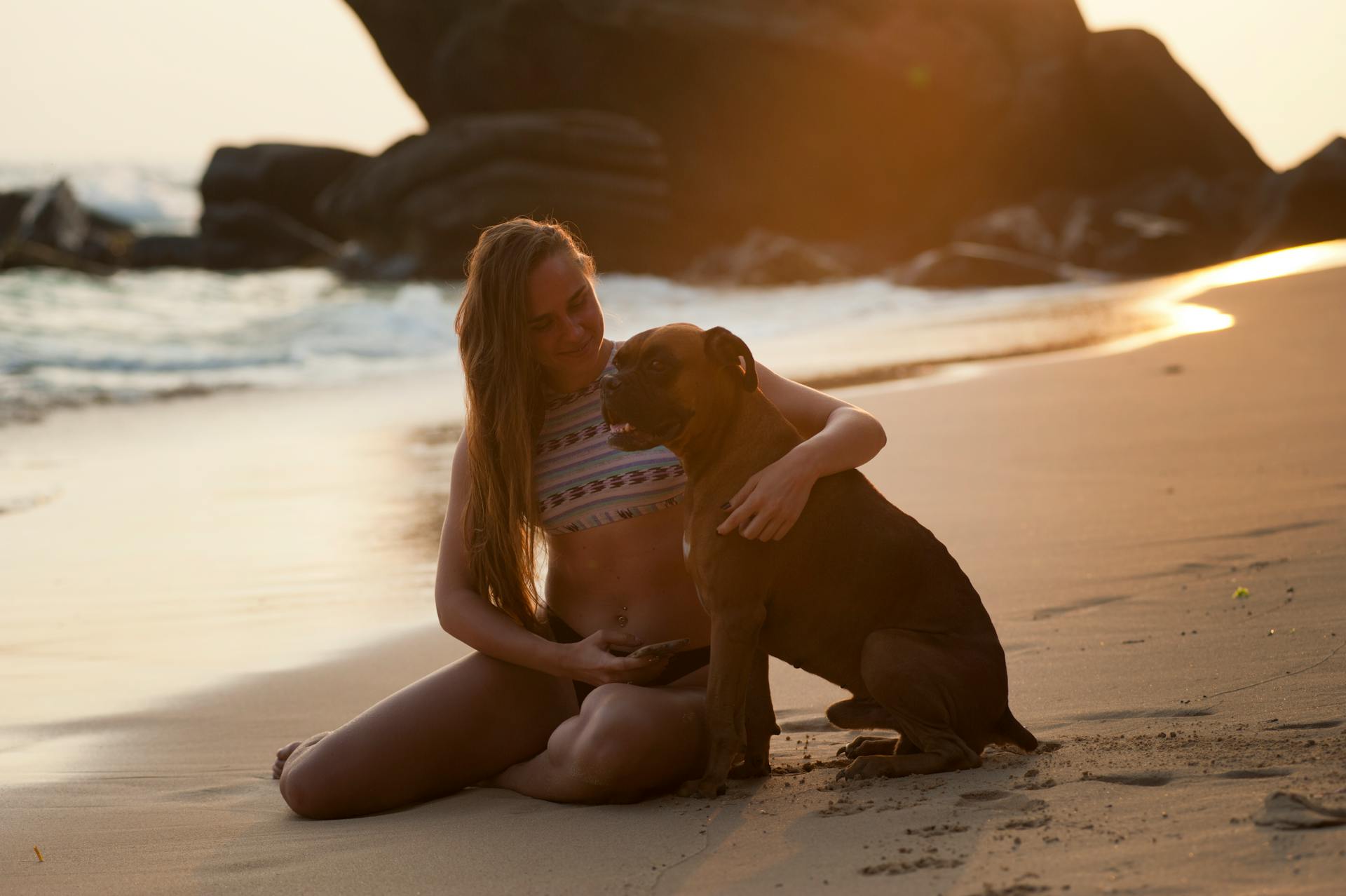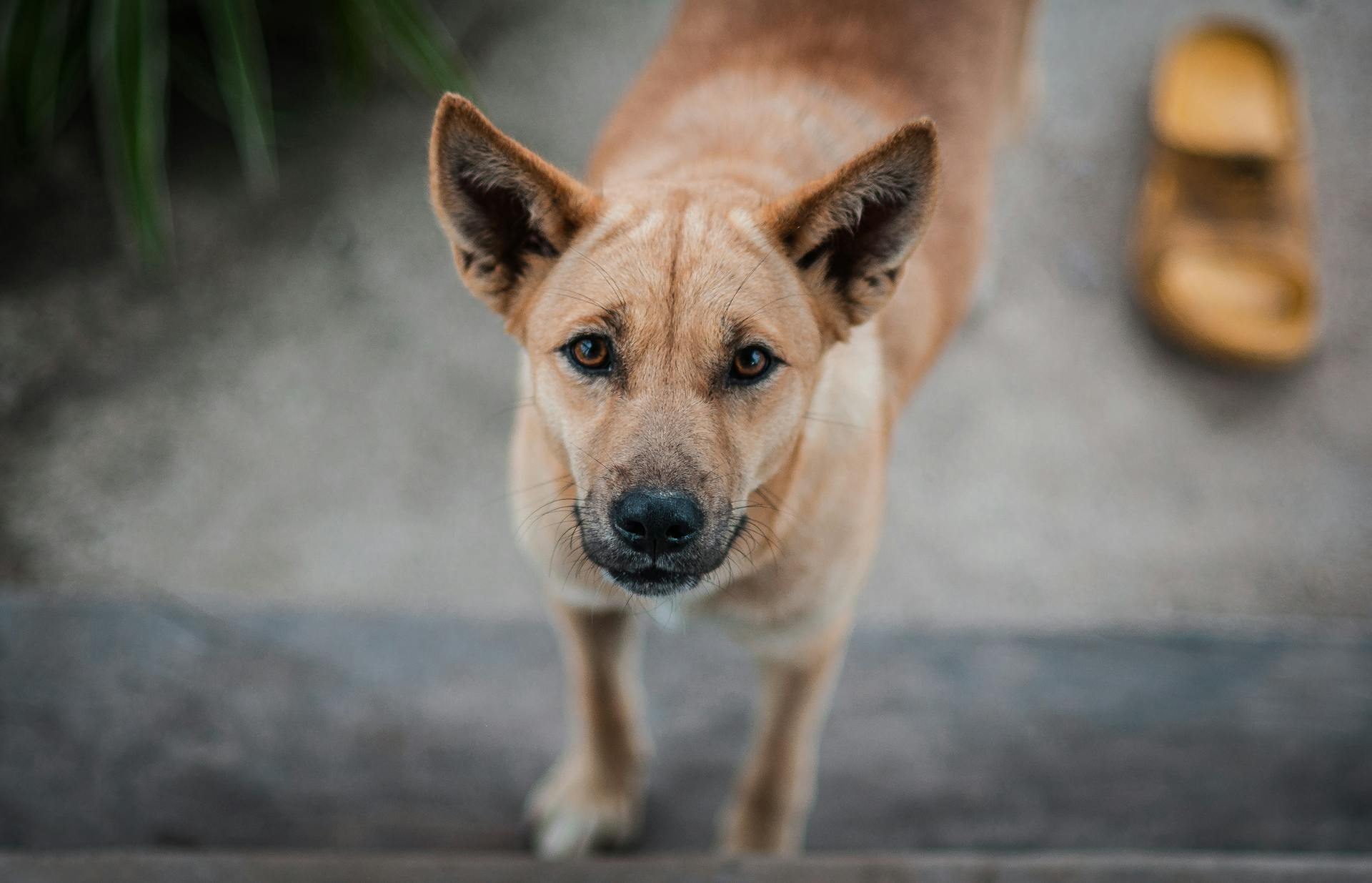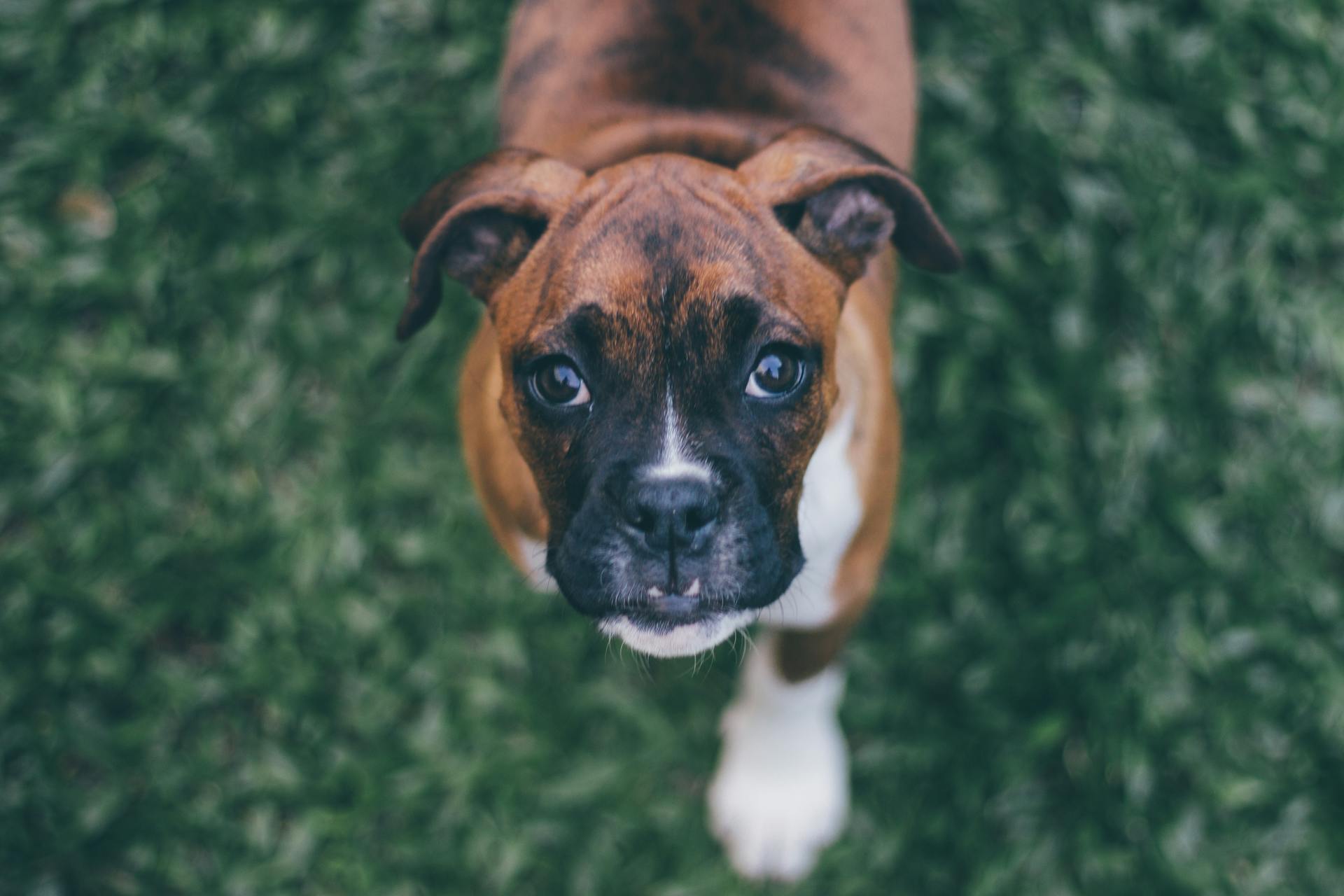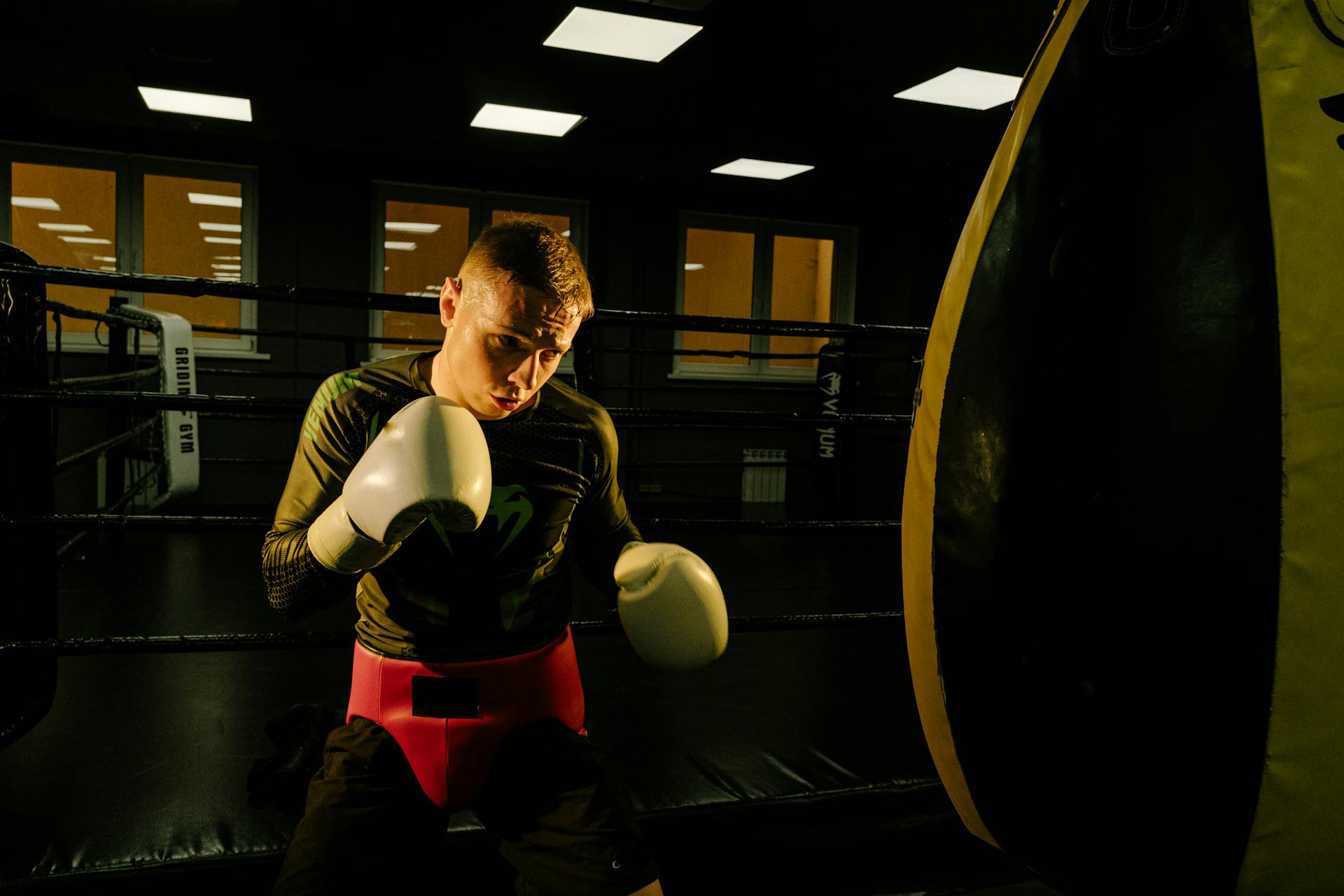
Training a boxer puppy requires patience, consistency, and positive reinforcement. Boxers are intelligent and energetic dogs that thrive on structure and clear communication.
Establish a routine early on, as boxer puppies have short attention spans and need frequent breaks. A consistent schedule helps prevent boredom and destructive behavior.
Housebreaking is a crucial aspect of training, and boxers typically learn quickly with positive reinforcement techniques. They can hold their bladder for about 1-2 hours, so be prepared to take them out frequently.
Positive reinforcement techniques, such as treats and praise, can help your boxer puppy learn basic obedience commands like "sit" and "stay."
Housebreaking
Housebreaking is a crucial part of training your Boxer puppy. Establish a potty schedule for your pup, taking them outside every 30 minutes to an hour, and use a timer to keep track.
A Boxer's clean nature makes them quick to pick up potty training. Remember that your puppy will need to potty within five to 15 minutes of eating, drinking, sleeping, or playing.
To create a Zen environment for your puppy, crate training is essential. The crate should be big enough for your pup to stand up, turn around, and stretch out. Don't keep them in there for more than four hours at a time.
Marking your pup's bathroom spot with a pet potty training spray can be helpful. Take your pup outside on his leash to the marked spot, and use the spray to coax them to go potty.
Be patient and give your pup 15 minutes to go potty. If they don't go, it's likely they don't need to. Take them inside and give them a few minutes before taking them out again.
To speed up the housebreaking process, use lots of praise and treats when your pup goes potty. Repeating this training until your pup lets you know when they need to go out is key.
Here's a quick rundown of the potty training schedule:
- Take your pup outside every 30 minutes to an hour
- Use a timer to keep track
- Mark your pup's bathroom spot with a pet potty training spray
- Be patient and give your pup 15 minutes to go potty
- Use lots of praise and treats when your pup goes potty
Training Tips
Training your Boxer puppy requires patience, consistency, and positive reinforcement. Boxers are of average working intelligence, but they excel at problem-solving and respond well to firm yet positive feedback.
To start training your Boxer puppy, it's essential to begin early and socialize them with both humans and other dogs. Enrolling in training classes as soon as possible will help them develop good habits and prevent boredom, which can lead to destructive behavior.
Some owners recommend a quick stroll before an obedience class to help their Boxer puppy mentally prepare for training. Starting early will improve training's odds of success, as will finding the right incentives for your dog. A treat-motivated Boxer, like Sadie, will learn quickly, but may choose to ignore you sometimes.
Here are some key training focuses for Boxer puppies:
- Helping them master the "down" command
- Controlling their urge to jump on and around those near them
Remember, repetition is key in training your Boxer puppy. Be patient and use plenty of praise and treats when they succeed.
Tips for
Training your Boxer puppy requires a consistent and positive approach. Start training as soon as possible, ideally from the get-go, to help your puppy learn good habits.
Boxers are intelligent dogs that benefit from mental stimulation, training, and exercise. They excel at problem-solving, so focus on interactive training rather than repetitive drills.
Socializing your Boxer early on is crucial, so introduce them to both humans and other dogs from an early age. Enroll them in training classes as soon as possible to help them develop good behavior.
To train your Boxer, use positive reinforcement techniques such as treats and praise. Be patient and consistent, and remember to keep training sessions short to avoid boredom.
Here are some key training goals to focus on:
- Get your Boxer used to basic grooming, such as wiping their muzzle and under their dewlaps
- Master the "down" command and control their urge to jump on and around others
- Use the leash method to train your pup to go potty outside
- Repeat the training process until your pup learns to let you know when they need to go out
Remember, every day is a school day for your Boxer puppy, so make the most of it by providing consistent training and positive reinforcement.
Learn Grooming Habits
Learning to groom your Boxer is a crucial part of their training. It's essential to get them used to basic grooming tools like brushes and washcloths from an early age.
Brushing is a great way to keep your Boxer's coat sleek and prevent shedding, which they excel at. Regular use of a firm bristle brush will make the process a breeze.
Some Boxers are fastidious and will even lick and groom themselves like cats do. However, this doesn't mean they won't need your help with grooming.
To get your Boxer comfortable with grooming, start by using a dampened washcloth to wipe between the folds on their muzzle and under their dewlaps to clean up drool. This will help them associate grooming with positive rewards.
It's also essential to get your Boxer used to being touched on sensitive areas like their muzzle, toes, body, tail, and hindquarters. This will make bath time and vet visits much easier.
Here are some key things to keep in mind when grooming your Boxer:
- Brush their coat regularly to prevent shedding
- Use a dampened washcloth to clean their muzzle and dewlaps
- Get them used to being touched on sensitive areas
- Bathe them only when necessary, using a high-quality shampoo and paying special attention to drying their facial folds
- Check their ears for signs of infection during grooming sessions
Socialization
Socialization is key for Boxer puppies, as it helps them become confident and calm in new situations. Boxers are fiercely protective of their owners, so proper socialization is a necessity.
You'll want to start socializing your Boxer puppy as soon as they enter their new home, ideally at 8 weeks old. Debra Henkle, a dog trainer and owner of Vendetta Boxers, recommends introducing your puppy to friendly people and pets, but with a few caveats: make sure visitors haven't been to places where they could have been exposed to dogs who may be sick.
Here are some key things to keep in mind when socializing your Boxer puppy:
- Get your puppy vaccinated before socializing them with other dogs and people.
- Enroll in the AKC Family Dog Program, which allows puppies as young as 8 weeks old to enroll if you provide proof of their first shots.
By following these tips, you'll be well on your way to raising a well-socialized Boxer puppy that will grow into a loyal and loving companion.
A Close Eye
As you're socializing your pup, it's essential to keep a close eye on them at all times, especially during potty training. This is where "A close eye" comes into play.
Pick a designated spot in the yard where you'll take your pup to go potty, and stick to it to avoid confusion. This will help them understand that this is their potty spot.
During potty training, if your pup shows signs of needing to go, take them straight out to their designated spot in the yard. Praise them and give them a treat when they do their business.
Keeping a close eye on your pup will also help you catch any signs of anxiety or stress that might arise during socialization. This can be especially important in new environments where they may feel overwhelmed.
Socialize with Dogs and People
Socialization is a crucial part of a boxer's life, and it begins the moment they enter their new home. Boxers are fiercely protective of their owners, so proper socialization is a necessity.
Boxers are very social dogs if introduced properly, according to Debra Henkle, dog trainer and owner of Vendetta Boxers in Vallejo, California. This means that owners should start introductions to friendly people and pets from a young age.
Puppies won't likely have all their shots until they are 16 weeks old, so make sure visitors haven't been to places like dog parks, pet stores, vets or other spots they could have been exposed to dogs who may be sick, advises Henkle.
Check this out: Dog Training Tips for Puppies
Enrolling in the AKC Family Dog Program is a great way to socialize your pooch. Most training clubs allow puppies as young as eight weeks old to enroll if you provide proof of the dog's first shots.
Boxers will rarely show aggression, but can be wary of strangers, making good socialisation from an early age essential. With proper socialization, boxers can take meeting new people and pets in their stride.
Here are some key socialization tips for boxers:
- Start introductions to friendly people and pets from a young age.
- Make sure visitors haven't been to places where they could have been exposed to sick dogs.
- Enroll in the AKC Family Dog Program to socialize your pooch.
- Provide proof of your dog's first shots to enroll in training clubs.
Basic Training
Training your Boxer puppy requires consistency and patience. Boxers are bright and energetic, so start teaching them basic obedience commands like 'Sit,' 'Stay,' and 'Come' immediately after bringing them home.
Consistency is key when it comes to training Boxers. They love to learn but can be stubborn and respond best to reward-based positive reinforcement training, with yummy rewards like small pieces of chicken or hot dog working best.
By one-year-old, your Boxer should have mastered many new skills, be completely potty trained, and enjoy meeting new people and pets. This growth stage is a great time to build on their training and reinforce good behaviors.
Your Basic Obedience
Your Boxer puppy is a quick learner, and it's essential to start teaching them basic obedience commands right away. This will help them understand what's expected of them and prevent destructive behaviors.
Start teaching your Boxer puppy basic obedience commands like "Sit", "Stay", and "Come" immediately after bringing them home. Boxers are bright and energetic, so consistency is key when it comes to training them.
Consistency is crucial when training Boxers. They love to learn but can be stubborn and respond best to reward-based positive reinforcement training. Yummy rewards like small pieces of chicken or hot dog work best.
To create a consistent routine, take your pup outside at the same times every day. This will help them learn when it's time to go potty and prevent accidents. Boxers are natural learners and thrive on routine.
Here are some essential basic obedience commands to teach your Boxer puppy:
- Sit
- Stay
- Come
- Walking nicely on a leash
- Going to the bathroom in the right place
Remember, every day's a school day for your Boxer puppy, so make the most of it and have fun with the training process!
Basic Facts

Boxers are a recognizable breed with a broad and blunt muzzle, and they come in a range of colors including light brown, brindle, and white.
The average height of a boxer is between 21.5 to 25 inches from floor to shoulder.
Boxers can weigh anywhere from 50 pounds for a small female to 80 pounds for a large male.
Their short coat is generally easy to maintain, but they do require regular grooming to prevent matting.
Boxers are known for their energetic and playful personalities, which can make training a fun and engaging experience.
On average, boxers live for around 10-12 years, and with proper care and attention, they can thrive in a variety of living situations.
Exercise and Nutrition
Boxers need at least two hours of exercise a day, spread out throughout the day, to keep them happy and healthy.
Boxer puppies continue growing for a long time, and will continue to broaden into adulthood, so it's essential to support their growth with the right nutrition.
A mix of wet and dry food is recommended for Boxers, with crunchy biscuits helping to maintain good dental health.
To reduce the risk of gastric problems, it's best not to feed your Boxer immediately before exercise.
Here's a rough guide to the daily exercise needs of Boxer puppies:
Remember to ease into any exercise routine, and don't forget to mix up your play sessions to keep your Boxer's mind and body active.
Mental and Physical Wellness
Boxers are intelligent breeds that thrive on human interaction and playtime, so it's essential to provide them with mental stimulation to prevent boredom.
They love to learn, so take them to puppy obedience classes from around 3 to 6 months old to teach basic commands and provide socialization experiences.
Boxers can exhibit a stubborn streak, so they respond best to positive reinforcement training methods.
To keep their minds active, mix up play sessions and consider enriching their day with challenges like food puzzles.
They also need physical exercise, with around 2 hours of activity per day, but moderation is key due to their short snouts and propensity for overheating.
Spread walks and exercise out throughout the day, and make sure their brain is getting a workout too.
A simple game of "fetch" is enough to keep your Boxer happy, but be careful not to overexert them and keep an eye out for signs of overheating.
Here are some exercise tips to keep your Boxer happy and healthy:
- Take them on two to three walks a day, with a mix of short and longer walks.
- Supplement walks with longer, brisker jaunts and games of catch.
- Consider enriching their day with challenges like food puzzles.
- Avoid outdoor exercise during extreme temperatures.
Grooming
Boxers are generally low maintenance when it comes to grooming, thanks to their short coats. Regular brushing with a firm bristle brush will keep their coat sleek and help prevent shedding.
You may need to brush gently over delicate areas like joints, tendons, and the head, as boxers' coats can be quite taut. Brushing regularly will also help prevent shedding, which they do excel at.
Boxers can be prolific droolers, so it's a good idea to keep wipes handy. Some owners even report that their boxers clean themselves like cats!
To get your boxer used to grooming, start by associating brushes and washcloths with positive rewards like food and praise. This will help them feel more comfortable with the process.
You should also get your boxer used to being touched on different areas of their body, such as the muzzle, toes, body, tail, and hindquarters. This will make bath time and vet visits less stressful for both of you.
Boxers do shed, but not too much, and they can be prone to sensitive skin. Bathing them too frequently can irritate their skin, so it's best to limit bathing to about every few months unless they get visibly dirty or smelly.
Here are some tips for bathing your boxer:
- Use a high-quality shampoo and rinse and dry properly to prevent skin irritation.
- Pay special attention to drying their facial folds, which can trap moisture and become infected.
- Check their ears for signs of infection, such as black or brown wax or a strange smell.
Remember, grooming sessions are also a good time to check your boxer's overall health and catch any potential issues early on.
Nutrition
Feeding your boxer the right food is crucial for their overall health and happiness. Boxers need digestible, complete, and balanced food that supplies enough energy for daily activities.
Readers also liked: Puppys Food
A fresh-food plan makes it easy to feed the right amount of food for their age, size, and activity level. This helps maintain a healthy weight, which is essential for their heart, joints, and metabolism.
Supporting heart and joint health is also vital. A fresh diet that provides balanced Omega-3 fatty acids may promote cardiac health and help ward off joint issues.
Crunchy kibble is often thought to clean teeth, but it doesn't actually do so. In fact, kibble can contain substances that fuel inflammation in the body, including in the tissues of the mouth.
A diet of fresh, lightly cooked food has been shown to be more digestible than processed kibble. This can promote a healthy gut and good digestion, which means better, smaller poops.
Here are some general guidelines for feeding your boxer:
• Feed a mix of wet and dry food for optimal nutrition
• Avoid feeding your boxer immediately before exercise to reduce the risk of gastric problems
• Provide crunchy biscuits to maintain good dental health and reduce bad breath
Preparation and Safety
Boxers are sensitive to extreme temperatures, so it's essential to keep them well-hydrated and protected from intense heat and sunshine.
In hot weather, avoid exposing your boxer to direct sunlight for extended periods. A shaded area or a cooling pad can be a lifesaver.
To keep your boxer warm in chilly weather, consider getting them a stylish coat to protect their short coat from the cold.
Common Health Concerns
As we prepare for emergencies, it's essential to be aware of common health concerns that can arise. Dehydration is a significant risk, especially in hot weather or during physical activity, and can lead to dizziness, headaches, and fatigue.
Some common signs of dehydration include dark yellow or brown urine, dry mouth, and decreased urine output.
Heat exhaustion can also occur, causing heavy sweating, pale skin, and fast or weak pulse. It's crucial to recognize these symptoms early on and take action.
According to the article, heat exhaustion can be treated by moving to a cooler location, removing excess clothing, and drinking cool water.
Avoid Extreme Temperatures
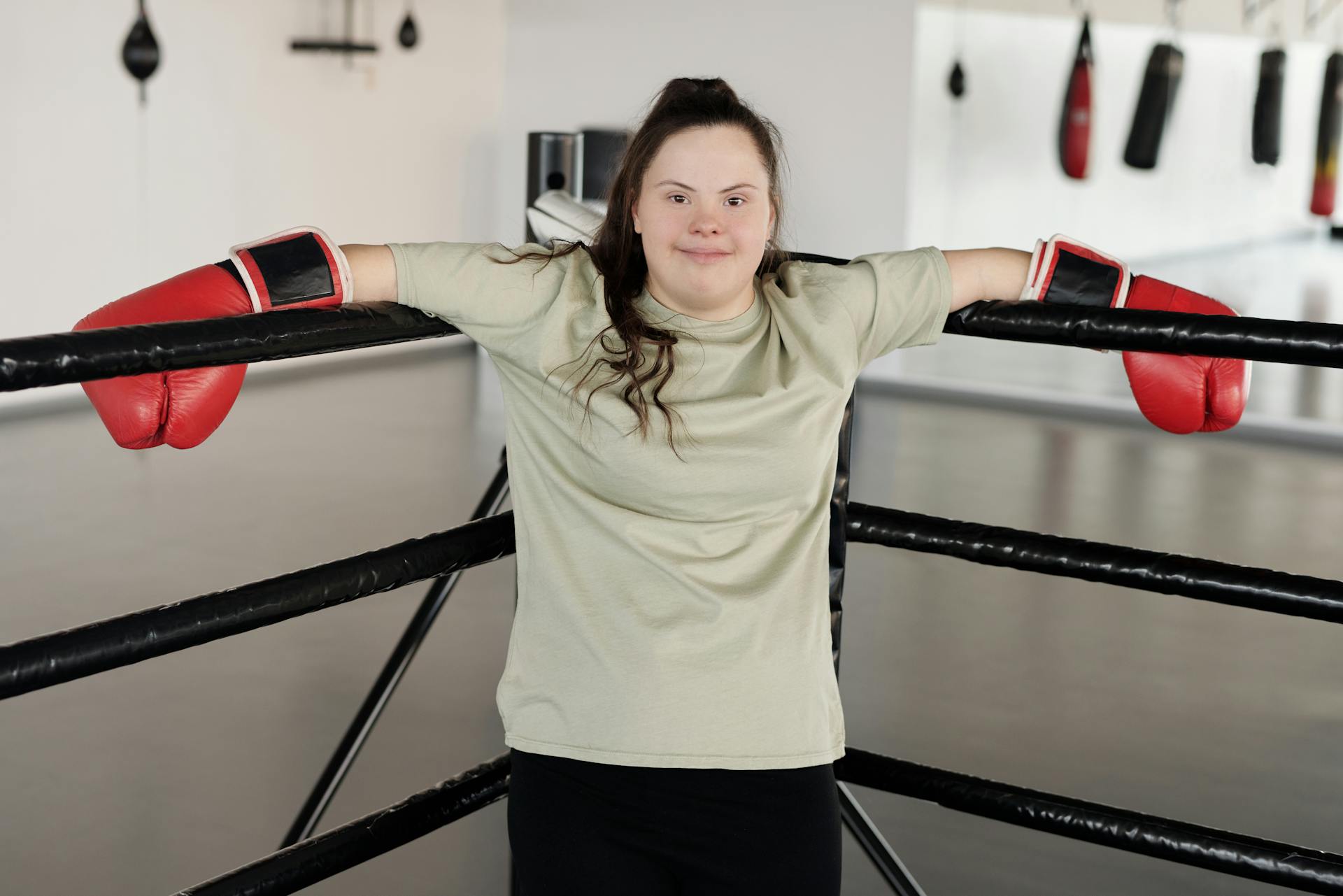
Boxers are sensitive to extreme temperatures due to their brachycephalic breed and short coat. They need to be kept well-hydrated to stay safe.
It's necessary to keep them out of intense heat and sunshine for an extended time. This will prevent heat-related issues.
Their short coat doesn't provide much protection against the cold, so it's best to dress them up in a stylish coat during chilly weather.
Program Overview
In this comprehensive guide, we're going to help you cover all the skills that will make your Boxer puppy the cleverest in town. We'll be covering a range of essential topics that every Boxer puppy needs to learn.
Housebreaking is a crucial part of a Boxer puppy's training, and we'll provide you with expert advice on how to do it successfully. This includes understanding your puppy's behavior, establishing a routine, and using positive reinforcement techniques.
We'll also cover obedience training, which will help you and your puppy develop a strong bond and improve communication. You'll learn how to teach your puppy basic commands like "sit", "stay", and "come."
Socialization is another vital aspect of a Boxer puppy's training, and we'll give you tips on how to introduce your puppy to new people, environments, and experiences. This will help your puppy become confident and calm in new situations.
Leash training is also an important part of a Boxer puppy's education, and we'll show you how to teach your puppy to walk on a leash without pulling. This will make walks with your puppy a joy, rather than a struggle.
By the end of this guide, you'll have a well-rounded and well-behaved Boxer puppy that you can be proud of.
Expand your knowledge: Leash Training Puppies
Common Questions
Here's what you need to know about training boxer puppies:
Boxer puppies need consistent training from an early age to develop good habits and prevent bad ones.
Puppies typically start teething around 3-4 months old, so be prepared for some chewing and gnawing on furniture and shoes.
To establish a routine, start with short training sessions of 5-10 minutes, twice a day.
Positive reinforcement is key when training boxer puppies, so be sure to reward good behavior with treats and praise.
Boxers are naturally energetic dogs and need plenty of exercise to stay happy and healthy.
If this caught your attention, see: When to Start Potty Training Puppies
Frequently Asked Questions
How to discipline a Boxer puppy?
To discipline a Boxer puppy effectively, use positive reinforcement techniques and set clear boundaries, focusing on rewarding good behavior rather than punishing bad behavior. Consistency and patience are key to teaching your puppy good manners and preventing unwanted habits.
What age can you start training a Boxer puppy?
Boxer puppies can start training as soon as possible, ideally from an early age. Early training sets the foundation for a well-behaved and well-adjusted adult Boxer
What is the best way to potty train a Boxer puppy?
To potty train a Boxer puppy, use positive reinforcement by immediately rewarding them with treats when they eliminate in the designated spot. Consistent and timely rewards will help your puppy learn to associate the behavior with a desired outcome.
Sources
- https://wagwalking.com/training/potty-train-a-boxer-puppy
- https://www.thefarmersdog.com/digest/the-boxer-breed-guide-personality-history-training-food-and-more/
- https://www.akc.org/expert-advice/dog-breeds/boxer-puppy-training-timeline-what-to-expect-and-when-to-expect-it/
- https://www.petplan.co.uk/pet-information/dog/breed/boxer/
- https://zigzag.dog/en-us/blog/puppy-training/breed-specific/guide-how-to-train-a-boxer-puppy/
Featured Images: pexels.com
